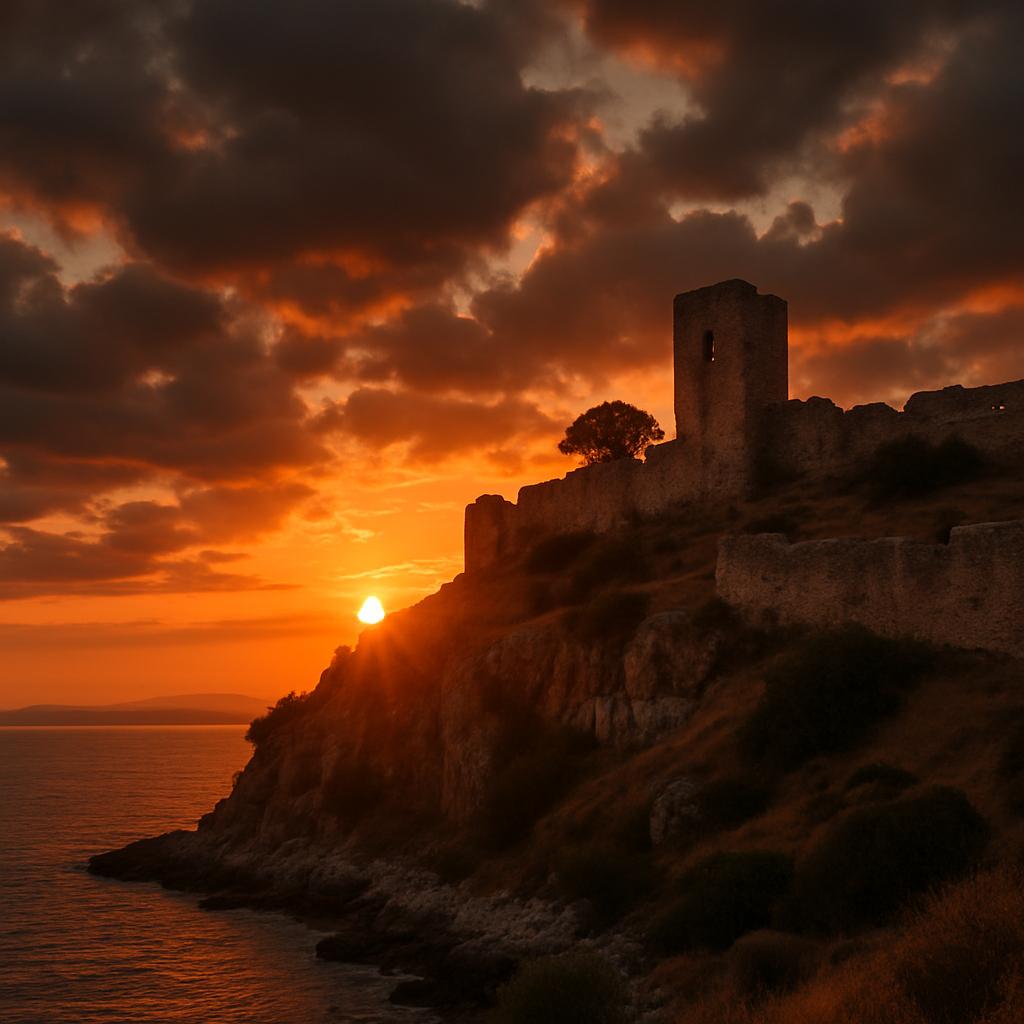The Old Navarino Castle: A Guardian of Time in Greece’s Messenian Bay
Some mornings, when the sea fog creeps across the Ionian waters and wraps itself around the craggy headland where Old Navarino Castle stands sentinel, I catch myself smiling like a fool. After spending 15 years guiding wide-eyed travelers through Greece's Peloponnese, this weatherbeaten fortress (or "Palaiokastro" as the locals affectionately mumble) still makes my heart skip when it appears through the mist.
Forget your Instagram-famous ruins - this place has soul.

A Timeless Sentinel Overlooking Navarino Bay
The Old Navarino Castle doesn't just sit on a cliff - it commands it like a grizzled sea captain. Perched a dizzying 200 meters above the waves on Navarino Bay's northern lip, this stone guardian offers views that have literally made my tourists weep.
I'll never forget the Canadian couple who rounded that final bend on the path and simply stopped breathing for a moment. The Old Navarino Castle materialized before them - sun-bleached limestone walls defiant against time, with the impossibly blue Ionian spread beneath like spilled paint and Sfaktiria Island stretching its lazy form across the bay entrance.
What gives this 13th-century Old Navarino Castle its magic isn't just impressive stonework or tactical positioning - it's how the damn place connects you physically to centuries of Mediterranean drama. Stand atop those ancient walls and close your eyes; you'll swear you hear phantom swords clashing while enjoying what might be western Greece's most jaw-dropping coastal panorama.
A Journey Through Time: The Castle's Rich History
If you want to understand the Mediterranean's complicated past, the story of Old Navarino Castle gives you the perfect crash course. I tell my groups that this fortress is basically a stone textbook of Greece's medieval soap opera.
Frankish Origins in the Wake of the Fourth Crusade
The Old Navarino Castle's birth certificate dates to about 1278, when Nicholas II de Saint Omer (fancy Frankish nobleman with too many names) directed its construction after the Fourth Crusade turned Byzantine territories upside down. The Franks originally called it "Port-de-Jonc" or "Zonklon" - poetic names inspired by the reeds that danced in the nearby lagoon.
What fascinates me about Old Navarino Castle is how it physically embodies cultural fusion. Look closely at these walls and you'll spot:
- Western European military design principles
- Byzantine construction techniques
- Stone bearing witness to civilizations colliding
- Architectural elements that tell stories words cannot
The Old Navarino Castle isn't just rock and mortar - it's a petrified cultural exchange program.
The Venetian Period: Maritime Republic's Expansion
By the late 1300s, Venice had its greedy mercantile eyes on strategic Mediterranean ports, and Old Navarino Castle became a prized jewel in their trading crown. Those practical Venetians didn't just admire the Old Navarino Castle - they rolled up their sleeves and gave it a serious upgrade, adding those distinctive rounded towers and thickening walls to withstand the newfangled threat of cannons.
Wander through Old Navarino Castle today and I'll point out something most visitors miss - a weather-worn Lion of St. Mark still defiantly guarding one of the remaining gates. This stone kitty is a subtle reminder that Venice once ruled these waves. The Venetians weren't fools; they recognized the natural harbor below Old Navarino Castle was maritime gold - sheltered by Sfaktiria Island and deep enough for their merchant ships to nestle safely.
Ottoman Control and the Castle's Strategic Importance
The Ottoman Empire came knocking in the late 15th century, and in 1500, Sultan Bayezid II captured the Old Navarino Castle, giving it the new name "Anavarin." The Ottomans held onto this strategic gem for most of the next three centuries (with a brief Venetian interruption between 1686-1715), using Old Navarino Castle to anchor their western sea frontier.
What makes my history buffs gasp is how clearly you can read Ottoman military thinking in the Old Navarino Castle's bones:
- Reinforced gun placements that speak of adaptation
- Modified battlements showing evolution in warfare
- Architectural adjustments revealing military innovation
- Each stone telling a story of empire and resistance
As we wander through the ruins, I challenge visitors to notice how each controlling power reshaped Old Navarino Castle according to their own military traditions and the ever-changing face of war.
The Greek War of Independence and the Battle of Navarino
The Old Navarino Castle's most dramatic chapter unfolded during the Greek War of Independence (1821-1829). By this point, the Ottomans had built New Navarino Castle (Neokastro) at the bay's southern entrance, creating a formidable defensive sandwich with our old stone friend.
October 20, 1827 changed everything. That's when British, French, and Russian navies teamed up to absolutely demolish the Ottoman-Egyptian fleet in Navarino Bay. While Old Navarino Castle didn't directly participate in this naval smackdown (the last major battle fought entirely with sailing ships), it stood as a silent witness to history's turning page.
When I bring visitors to the Old Navarino Castle walls overlooking that peaceful bay, I often fall quiet. Let them absorb it - right below us, the waters that birthed modern Greece still whisper stories of wooden ships and iron determination.
Exploring the Castle Today: A Visitor's Guide
Getting There: The Journey Is Part of the Adventure
Reaching Old Navarino Castle requires actual effort - which is precisely why it remains deliciously authentic. About 13km north of Pylos town, you'll find yourself navigating a road that seems to lose interest in being paved, followed by a footpath that will make you question your footwear choices.
I always tell my clients three things about visiting Old Navarino Castle:
- Wear shoes you wouldn't mind hiking a small mountain in
- Bring water - summer turns the path to Old Navarino Castle into a Greek sauna
- Prepare for views that make the sweat worthwhile
The approach to Old Navarino Castle gifts you with spectacular vistas of Voidokilia Beach - a perfect omega-shaped curve of sand that Homer claimed was Telemachus's landing spot while searching for Odysseus. This mythological connection adds another delicious layer to your Old Navarino Castle adventure.
What You'll See: Architectural Features and Highlights
Time hasn't been gentle with Old Navarino Castle, but what remains packs a historical punch. The main gate stands defiant, significant sections of curtain walls still guard against phantom invaders, and several towers continue their centuries-long watch over the bay.
Inside Old Navarino Castle's embrace, you'll discover:
- Ruins of a humble church where soldiers once prayed
- Cisterns that once meant life during siege
- Military structures that housed men far from home
- Stones that have witnessed empires rise and fall
What consistently makes visitors whistle in appreciation is how cleverly Old Navarino Castle's builders incorporated the natural landscape. They let those dizzying seaward cliffs handle defense on one side while focusing their construction genius on the vulnerable land approaches. Medieval military engineering at its most practical and brilliant.
The Unmissable Views: Photographic Opportunities
I've dragged my camera through countless Greek ruins, and I swear on my grandmother's olive oil that Old Navarino Castle offers views that border on the ridiculous. From its eagle-nest position, your eyes (and lens) can capture:
- Navarino Bay's entirety - water so clear you can count fish from above
- Sfaktiria Island lounging across the horizon like a sleepy sea monster
- Voidokilia Beach's perfect mathematical curve to the north
- New Navarino Castle (Neokastro) standing guard to the south
- On clear days, the distant Mani Peninsula floating like a mirage
Pro tip from a weathered guide: visit Old Navarino Castle as the afternoon mellows. That golden light transforms the landscape into something that will break your camera's heart. When sunset paints the Ionian in oranges and purples beneath those ancient walls, you'll understand why I've returned hundreds of times and never grown bored.
Why You Should Include Old Navarino Castle in Your Greek Itinerary
Beyond the Typical Tourist Trail
While hordes of tourists elbow each other for selfies at the Acropolis, Old Navarino Castle offers something increasingly precious: breathing room. Even in August's tourist tsunami, you might find yourself alone among these storied ruins, free to commune with history without someone's selfie stick in your ear.
This blessed solitude at Old Navarino Castle creates space for those magic travel moments that justify passport stamps. I've watched countless visitors experience that rare quiet joy that comes from discovering something that feels like a secret between them and Greece.
A Natural and Historical Combination
What makes Old Navarino Castle exceptional is its perfect marriage of human achievement and natural splendor. Few archaeological sites in Greece offer such harmonious blending of stories told in stone and beauty written in landscape. The Old Navarino Castle anchors an ecosystem that includes:
- Gialova Lagoon - where flamingos strut and rare birds find sanctuary
- Voidokilia Beach - a perfect semicircle that looks photoshopped but isn't
- Divari Beach - where golden sand stretches toward infinity
- Navarino Bay's marine environment - teeming with life beneath crystal waters
This combination makes Old Navarino Castle satisfying on multiple levels - history nerds, nature lovers, and photography addicts all leave equally satisfied.
Cultural Immersion in the Nearby Villages
After exploring Old Navarino Castle's weathered stones, I always push my groups to visit the surrounding villages where Greece continues unchanged by mass tourism's heavy hand. Tavernas in Gialova and Pylos serve food that makes you understand why Greek grandmothers live forever - dishes swimming in local olive oil, seafood still tasting of salt water, and produce picked that morning.
The local folks, many with family stories intertwined with Old Navarino Castle and its famous naval battle, add human warmth to historical understanding. More than once, my clients have ended up drinking homemade wine at impromptu village celebrations simply because they showed genuine interest in local stories about Old Navarino Castle.
Practical Tips for Visiting Old Navarino Castle
Best Time to Visit
Old Navarino Castle welcomes visitors year-round, but timing matters:
- Spring (April-June): Wildflowers carpet the approach, temperatures forgive, and the light dances
- Early autumn (September-October): Golden warmth without summer's intensity
- Summer (July-August): Scorching but sea breezes offer mercy
- Winter: Dramatically moody skies and welcome solitude, though rain might dampen spirits
What to Bring
Fifteen years of guiding visitors to Old Navarino Castle has taught me what you'll need:
- Footwear with actual grip (Old Navarino Castle's pathways laugh at flip-flops)
- Hat and sunscreen (shade at Old Navarino Castle is as rare as a quiet Greek grandmother)
- Water and snacks (Old Navarino Castle offers history, not conveniences)
- Camera with backup batteries (you'll shoot more photos than you think)
- Binoculars for spotting distant details and birds
- Light windbreaker (Old Navarino Castle's exposed position can turn breezy without warning)
Combining Your Visit with Other Local Attractions
Make your journey to Old Navarino Castle the centerpiece of a regional exploration:
- New Navarino Castle (Neokastro) in Pylos houses an excellent museum
- Palace of Nestor offers Mycenaean wonders for archaeology enthusiasts
- Methoni Castle provides another coastal fortress fix about 20km south
- Pylos town welcomes with a picture-perfect square and harbor
- Voidokilia Beach invites swimming in waters clear enough to count sand grains
Experience Old Navarino Castle with Unique Greek Tours
After fifteen years introducing wide-eyed travelers to the Peloponnese's hidden corners, I've learned that Old Navarino Castle reveals its deepest secrets only to those who come prepared with context and stories.
At Unique Greek Tours (https://www.uniquegreektours.com/en/), we don't just show you Old Navarino Castle - we help you experience it through multiple lenses. Our Messenia heritage tours feature Old Navarino Castle as their crown jewel, providing historical background that brings those sun-baked stones to vibrant life.
Our guides share more than dry facts about Old Navarino Castle - we offer local legends whispered over generations, personal family connections to the region, and cultural insights that transform a pile of old rocks into a chapter of living history. We time our Old Navarino Castle visits to avoid crowds and capture the most flattering light, and can arrange special experiences like sunset picnics featuring local delicacies with Old Navarino Castle as your dining backdrop.
Old Navarino Castle isn't just another checkbox on a tourist itinerary—it's a time portal to Greece's complex medieval story, a viewpoint for appreciating some of the country's most breathtaking natural scenery, and a place where history feels close enough to touch. Whether you're a history nerd, photography enthusiast, or simply someone hungry for authentic travel moments, this ancient guardian watching over the Ionian promises memories that will linger long after your footprints in Greek sand have washed away.








